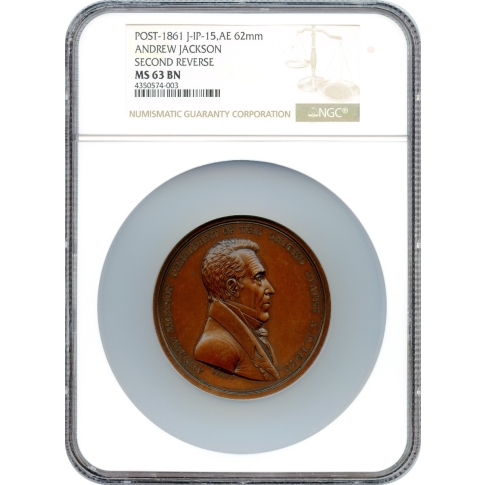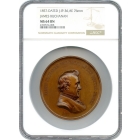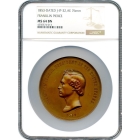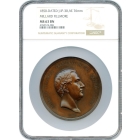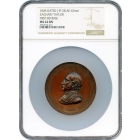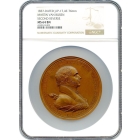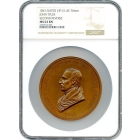Indian Peace Medal - 1829 Andrew Jackson, J-IP-15 Second Reverse AE 62mm NGC MS63
Peace Medals were instrumental in building relationships with the various Indian Tribes. American Presidents (and their Colonial predecessors) used Indian Peace Medals as a way of placating various tribes and/or to build alliances with them. The recipients valued them highly, for they conferred a prestige that was recognized throughout the nation. The Bureau of Indian Affairs considered them crucial and the Presidents for whom they were issued also knew their importance. Many images from the "Old West" show Indians proudly wearing their Peace Medals (sometimes more than one). Generally, bronze medals were not used for presentation purposes, but in some cases, they were silver-plated and either given, sold, or traded away by unscrupulous individuals to unwitting recipients.
NGC total census of only 2 medals certified as 62mm - the present example and a MS65. There are 2 certified as under the 63mm variety as well.
Andrew Jackson Indian Peace Medals
It was only ten days after the inauguration of Andrew Jackson that Thomas L. McKenney wrote to John H. Eaton, the new Secretary of War, in order to authorize his hiring a die sinker to create the medals. He wanted to hire Moritz Fürst, who had designed the Madison and John Quincy Adams medals, again at the same rate ($1,000) to create three dies of Jackson, and order 100 each of the three medals to be produced at the Philadelphia Mint. His request was ignored by Eaton, and McKenney wrote to him again at the end of the year, explaining the significance of the medals to the Indians. Yet again Eaton did not answer him, and nothing was done about the medals before McKenney left his position in September 1830. Samuel S. Hamilton replaced him, and wrote to Fürst about crafting the dies, and Samuel Moore, Mint Director, who agreed to have the medals struck at the Mint by Chief Coiner Eckfeldt. It was on the 16th of May, 1831, that Fürst sent an impression of the larger die to the Indian Office. Fürst wrote, "...I have no doubt but you will be satisfied with it. It is certainly equal in point of execution to anything I have ever done." On June 3, Fürst reported that all three dies had been sent to Eckfeldt at the Mint.
There were delays in striking the medals at the Mint as the Indian Office was overwhelmed with requests from the frontier for medals to give to Indian chiefs. The heavy press employed to produce medals had to be repaired, and the coiner was busy with the day to day operations of the Mint. Also Eckfeldt, the coiner, who produced the medals, had seriously injured his knee in a fall. He returned to work but still had pain and difficulty walking. There were also problems with packages of medals being shipped from Philadelphia to Washington. The post office in Philadelphia refused to accept for shipment a box of 20 medals. Then Mint Director Moore wrote for directions from Washington on how to ship the medals. Elbert Herring replaced Hamilton at the Indian Office and was frustrated by the inefficiency of the Mint. It was now three years after Jackson's inauguration and not a single medal bearing him image had arrived in Washington. It was on March 6, 1832, that Herring wrote a severe letter to Moore. But before receiving the letter, packages filled with medals, one or two at a time, day after day, were being shipped from the Mint to the Indian Office. It was on March 16 that Moore wrote Herring that, "The requisite number it is supposed has now been completed."
Andrew Jackson and the Indians
Nicknamed "Sharp Knife" and "Indian Killer," Andrew Jackson "was a forceful proponent of Indian removal," according to PBS. A wealthy slave owner and infamous Indian killer, he was chosen by President Jefferson to take Creek and Cherokee lands. His brutality was no secret. Jackson suggested that his troops systematically murder Indian women and children after massacres in order to complete the slaughter. The Creek Indians lost 23 million acres of land in Central Alabama and southern Georgia, which was land later used for cotton plantations and slavery. His warfare and negotiations after conclusion of battles opened up a big chunk of the southeast to settler migration.
Jackson invaded Spanish Florida in 1818 in order to locate runaway slaves and return them to their owners. He also instigated the First Seminole War. During that war Jackson captured two British men who lived among the Seminoles, who had resisted the invasion. One of the Brits had written about his support for the Indians' treaty and land rights in some documents found in a boat. Jackson used this "evidence" in order to accuse the Brits of "inciting" the Seminole Indians to wage "savage warfare" against the Americans. He then held a "special court martial" hearing and had the two men executed. It was in 1830 that Jackson signed the Indian Removal Act, which made ethnic cleansing legal. It took seven years for 46,000 Indians to be removed from their homelands east of the Mississippi. Removing those people provided 25 million acres of land to white settlers and slavery. The people dispossessed of their land were Cherokee, Creek, Choctaw, Chickasaw and Seminole Indians.
Jackson Indian Peace Medals struck for Indians and Collectors
Dated 1829, all original Jackson IPMs were struck on solid silver planchets. They were produced in three sizes: 76 mm, 62 mm, and 51 mm. It was in June of 2006 that an original small (51 mm) Jackson IPM graded VF 25 by NGC was auctioned off by Heritage at a price of $10,062.50. Restrikes of the Jackson IPM have been struck at the Mint (in different sizes) in bronze and sold to collectors and the general public since 1861.
| Grading Service | NONE |
|---|---|
| Year of Issue | NONE |
| Grade | NONE |
| Denom Type | N/A |
| Numeric Denomination | Medal |
| Mint Location | NONE |
| Designation | NONE |
| Circ/UnCirc | Not Specified |
| Strike Type | N/A |
| Holder Variety | Andrew Jackson: J-IP-15, AE, 62mm Second Reverse |
| Grade Add On | NONE |
| Holder Type | N/A |

